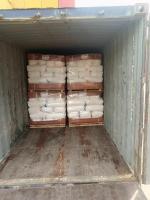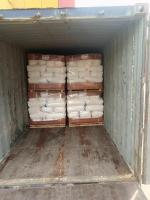Our Products
Polyacrylamide / cationic polyacrylamide zetag 9214-DE zetag 9216 can be replaced by Chinafloc C

cationic polyacrylamide zetag 9214-DE zetag 9216 can be replaced by Chinafloc C
zetag 9214-DE zetag 9216 are two models with lower cationic charge and linear structure.mainly used for municipal and some industrial wastewater treatment.Chinafloc C series can replace of them with better performance.
Cationic polyacrylamide (CPAM) with a lower cationic charge is a specialized version of polyacrylamide used in applications where a moderate level of electrostatic interaction is required between the polymer and the materials it interacts with. The degree of cationic charge on the polymer influences its effectiveness in flocculation, coagulation, dewatering, and other processes involving the aggregation of negatively charged particles. Lower cationic charge CPAM is particularly suited for scenarios where excessive electrostatic attraction might not be desirable or where a more controlled interaction is needed. In this detailed 1000-1200 word discussion, we explore the main applications of cationic polyacrylamide with a lower cationic charge, focusing on sectors like wastewater treatment, papermaking, sludge dewatering, textile processing, and oil recovery.
1. Wastewater Treatment
Cationic polyacrylamide with lower cationic charge is often used in wastewater treatment applications, particularly in industries that generate effluents with a moderate amount of organic and inorganic contaminants. It is highly effective in treating water that contains a combination of organic pollutants and suspended solids, making it ideal for applications in municipal and industrial wastewater systems.
Mechanism in Wastewater Treatment
In wastewater treatment, CPAM with lower cationic charge works by partially neutralizing the negative surface charges of suspended solids, including colloidal particles, organic matter, and fine particulates. The polymer chains help bridge these particles, encouraging the formation of larger aggregates or flocs. This aggregation aids in the settling, flotation, or filtration of solids, resulting in cleaner effluent.
The lower cationic charge ensures a controlled interaction between the polymer and the wastewater contaminants. This prevents over-flocculation, which could lead to excess sludge production and potentially hinder the downstream processing steps.
Applications in Wastewater Treatment Systems
- Municipal Wastewater: In municipal wastewater treatment plants, lower cationic charge CPAM is effective in primary and secondary treatment processes. It is used to remove organic matter and suspended solids while maintaining the delicate balance of floc formation without generating excessive sludge.
- Industrial Wastewater: Industries like food processing, dairy, beverage manufacturing, and chemical production often produce wastewater with organic pollutants. CPAM with a lower cationic charge is suitable for treating this type of effluent, allowing for improved solid-liquid separation and reduced water turbidity.
2. Sludge Dewatering
In sludge dewatering, the use of cationic polyacrylamide with a lower cationic charge is ideal when dealing with mixed sludge or sludges with moderate organic content. Dewatering is a critical process for reducing the volume of sludge, making its disposal more cost-effective and manageable.
How CPAM Works in Dewatering
Sludge typically contains fine particles, water, and organic or inorganic materials that must be separated to reduce the water content. CPAM with a lower cationic charge helps bind the sludge particles together, forming larger flocs that are easier to dewater. Its moderate charge is suitable for balancing the need for floc formation without over-condensing the sludge, which can result in excessive water retention or make the sludge more difficult to process.
The lower cationic charge makes this polymer particularly effective in situations where the sludge has a more complex composition, containing a mix of organic and inorganic materials that require a nuanced approach to flocculation and dewatering.
Applications in Various Sectors
- Municipal Sludge: In municipal wastewater treatment plants, lower cationic charge CPAM is often used in the dewatering of sludge generated during the treatment process. This helps reduce the volume of sludge that needs to be transported and disposed of, improving the overall efficiency of the treatment plant.
- Industrial Sludge: In industries such as mining, petrochemicals, and food processing, where sludge composition may vary, CPAM with lower cationic charge is used to balance floc formation and water removal. This ensures efficient dewatering without generating overly dense sludge that is difficult to handle.
3. Papermaking Industry
The papermaking industry is another area where cationic polyacrylamide with lower cationic charge is widely used. In this industry, CPAM plays a key role in improving paper quality, enhancing retention of fibers and fillers, and reducing water consumption during the manufacturing process.
CPAM as a Retention Agent
During the papermaking process, maintaining the retention of fibers and fillers is critical for product quality. Cationic polyacrylamide with a lower cationic charge acts as an effective retention agent by neutralizing the negative charges on the fibers and fillers, helping them stay bound to the forming paper sheet. The lower charge ensures that the interaction is not too aggressive, which would lead to excessive binding and impact the quality of the paper.
CPAM as a Drainage Aid
The polymer also serves as a drainage aid, helping to remove excess water from the pulp slurry. A lower cationic charge is particularly suitable for applications where controlled water removal is necessary to balance production speed and product quality. This contributes to energy savings by reducing the need for extensive drying of the paper.
Applications in Papermaking
- Fine Paper: For the production of fine paper products, CPAM with a lower cationic charge ensures that the retention of fibers and fillers is optimized without compromising the quality of the paper.
- Recycled Paper: In the production of recycled paper, lower cationic charge CPAM is used to treat the fibers and improve the retention of fillers and additives that enhance the strength and appearance of the final product.
4. Textile Processing
The textile industry benefits from the use of cationic polyacrylamide with lower cationic charge, particularly in applications involving dye fixation, wastewater treatment, and fabric conditioning. Textile manufacturing processes produce significant amounts of wastewater containing dyes, chemicals, and other contaminants that must be treated before discharge.
Dye Fixation
In textile dyeing, CPAM with a lower cationic charge is used to improve dye fixation on fabric fibers. The polymer binds to the negatively charged dye molecules, helping them adhere more effectively to the fibers. This prevents the dyes from washing out during subsequent rinsing stages, reducing water usage and improving dye efficiency.
Wastewater Treatment in Textile Mills
CPAM with lower cationic charge is also used in treating wastewater generated during textile production. The polymer helps coagulate and flocculate suspended solids, dyes, and chemicals in the effluent, allowing them to be removed more easily through sedimentation or filtration. The lower charge ensures that the treatment process is effective without over-flocculating, which could hinder further treatment processes.
5. Oil and Gas Industry
In the oil and gas industry, CPAM with lower cationic charge is employed in various processes, including enhanced oil recovery (EOR), drilling mud stabilization, and the treatment of oily wastewater.
Enhanced Oil Recovery (EOR)
During enhanced oil recovery, polymers are injected into oil reservoirs to improve the viscosity of the displacing water, enabling it to sweep oil from the reservoir more effectively. CPAM with a lower cationic charge is ideal for conditions where the oil reservoir contains a moderate amount of brine or where the need for controlled interaction between the polymer and reservoir fluids is necessary. This allows for better oil displacement while minimizing potential negative interactions between the polymer and the reservoir matrix.
Drilling Fluid Stabilization
Lower cationic charge CPAM is also used in drilling fluids, where it acts as a stabilizer and viscosifier. Its role is to control fluid loss, enhance the suspension of cuttings, and prevent wellbore instability. The moderate charge level ensures that the polymer interacts effectively with the materials in the well without causing excessive gel formation, which could lead to operational issues.
6. Environmental Applications
Cationic polyacrylamide with lower cationic charge is also important in environmental applications, particularly in the treatment of water and soil contaminated with organic and inorganic pollutants. Its ability to flocculate suspended particles and neutralize contaminants makes it an essential tool in environmental remediation projects.
Water Treatment
Lower cationic charge CPAM is used in treating water sources contaminated with moderate levels of pollutants. The polymer helps remove suspended solids, organic materials, and certain heavy metals by promoting floc formation, which can then be removed through sedimentation or filtration.
Soil Remediation
In soil remediation projects, CPAM is used to stabilize contaminated soils and prevent pollutants from leaching into groundwater. The lower cationic charge ensures that the polymer interacts effectively with the soil without over-compacting it, allowing for better water infiltration and soil aeration.





